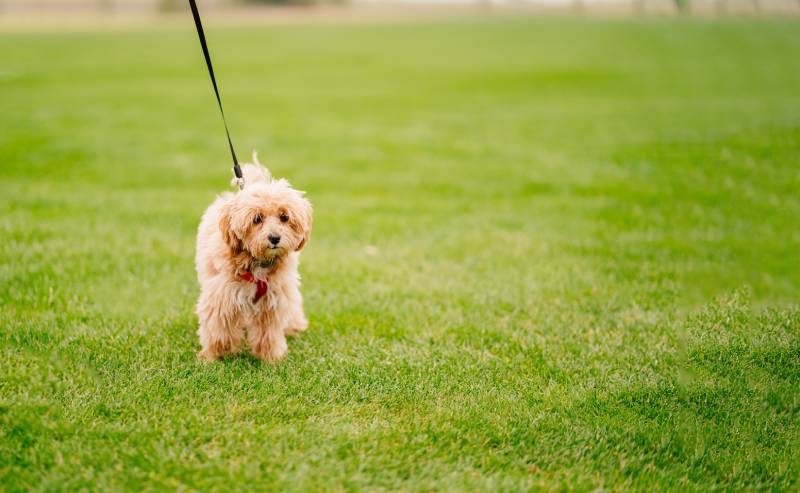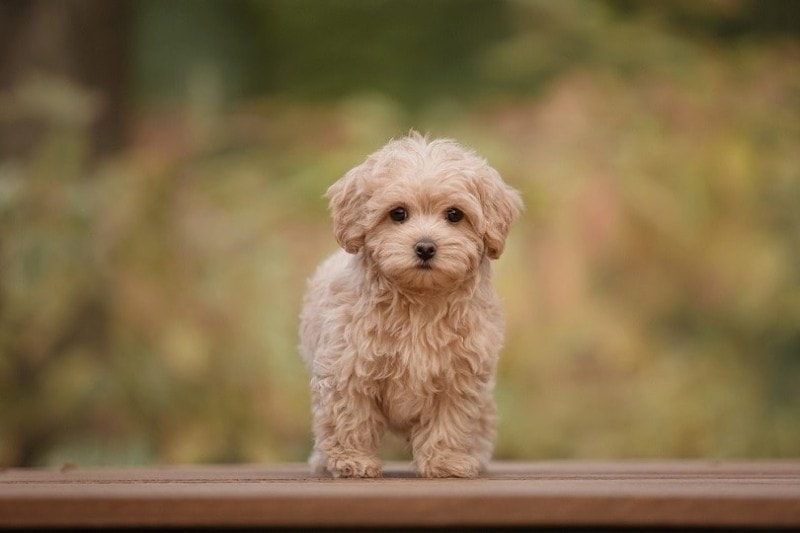Click to Skip Ahead
Adorable, playful, and social are three words that describe the Maltipoo perfectly. These small, affectionate, and gentle dogs have become quite popular since their introduction, and the Apricot Maltipoo, with its beautifully colored coat, leads the proverbial pack.
Breed Overview
Height:
6 – 14 inches
Weight:
5 – 12 pounds
Lifespan:
12 – 15 years
Colors:
Black, apricot, tan, cream, white
Suitable for:
Children, small houses, apartments
Temperament:
Friendly, active, intelligent, outgoing
Apricot Maltipoos can come in darker and lighter shades, depending on the genes they inherit from their doggy parents. If you’re interested in adopting an Apricot Maltipoo and want to learn more before you do, read on for more information about the extraordinary canine.
Maltipoo Characteristics
The Earliest Records of Apricot Maltipoos in History
The Apricot Maltipoo is one of the many color variations of the Maltipoo, which is a “designer” breed of dog that’s the result of breeding a Maltese and a Toy or Miniature Poodle. The history of the Maltipoo, and thus the Apricot Maltipoo, is short, as they were first produced in the 1990s. The history of the Maltese and the Poodle goes back quite a bit further.
Dog experts believe the Maltese breed is possibly the oldest in recorded history, first seen in Malta around 3500 B.C. The Poodle was first seen in Germany around the 15th century. The combination of the two make for a truly remarkable dog.
How Apricot Maltipoos Gained Popularity
Maltipoos, including Apricot Maltipoos, have only been around for about 30 years, which is an admittedly short time for any dog breed. During that time, however, Maltipoos have become a darling of the dog world due to their friendly demeanor, playful nature, and adorable features.
Breeders wanted a dog that would be intelligent and affectionate and would get along well with everyone. They also wanted a small dog that shed very little, caused few allergy problems, could live in a small space like an apartment, and was easy to care for. Breeders were successful on all of those counts, and because of that success, the Maltipoo and Apricot Maltipoo have been popular ever since.

Formal Recognition of the Apricot Maltipoo
While the Apricot Maltipoo isn’t recognized by the American Kennel Club (AKC), it is recognized by several other dog clubs and organizations. They include the following:
- American Canine Hybrid Club
- Designer Breed Registry
- Designer Canine Registry
- Designer Dogs Kennel Club
- Continental Kennel Club
Unfortunately, the AKC isn’t known for recognizing hybrid or designer dog breeds, but that doesn’t make the Apricot Maltipoo any less desirable or attractive. However, the Maltese and the Poodle have been recognized by the AKC for many years. Apricot Maltipoo owners are thus hopeful that, one day, their beloved breed will be approved. Until then, they have to settle for having an affectionate, charming, and smart dog that loves them with all its heart.
Top 12 Unique Facts About Apricot Maltipoos
Want to know more about the Apricot Maltipoo? Below are 12 unique facts about the breed that will give you more insight.
1. They Come in Several Shades of Apricot
There are several shades of Apricot Maltipoo; some are lighter or darker than others. Their full color doesn’t show until Apricot Maltipoos are about 6 months old.
2. Apricot Maltipoos Can Change Color
Most Apricot Maltipoos will change color over their lifetime, getting lighter as they age. Many will be more of a cream color as senior dogs.

3. Apricot Maltipoos Are Almost Hypoallergenic
Because of their Maltese and Poodle heritage, most Apricot Maltipoos are nearly hypoallergenic. They do shed, but very little. Also, because they only have one coat of hair, dander doesn’t cling to Apricot Maltipoos but mainly falls off. In short, Apricot Maltipoos are excellent dogs for allergy sufferers.
4. They’re Called Many Different Names
Because the Maltipoo is a hybrid dog that the AKC does not yet recognize, they have been given various names besides Maltipoo, including Malt-Oodle, Multapoo, Moodle, MaltiPoodle, Multipoo, and several others.
5. Apricot Maltipoos Never Grow Up
Like Peter Pan, Apricots and other colors of Maltipoo tend to remain child-like even as older dogs and stay playful, outgoing, silly, and always ready for fun.
6. Maltipoos Can Be Bred From Toy and Miniature Poodles
If you want a larger Apricot Maltipoo, look for one that resulted from a cross between a Miniature poodle and a Maltese. For a smaller Apricot Maltipoo, a Maltese bred with a Toy Poodle is your best bet.

7. Barking Is an Activity Apricot Maltipoos Like a Lot
As with many other small breeds, the Apricot Maltipoo loves to bark and will bark for just about any reason. That’s helpful when someone enters your property, but owning an Apricot Maltipoo might be challenging in a situation where excessive noise could cause problems.
8. The Generation Makes a Difference
When looking for an Apricot Maltipoo, you should ask which generation they are. For example, an F1 Apricot Maltipoo results from a cross between a Maltese and a Toy or Miniature Poodle. An F2, however, is a cross between two Maltipoos.
9. Apricot Is a Popular Maltipoo Color
There are several colors of Maltipoos, but few are as beloved as the Apricot Maltipoo. Indeed, apricot is considered to be the most popular of all the Maltipoo colors.
10. Apricot Maltipoos Don’t Do Well Alone
If you decide to adopt an Apricot Maltipoo, it’s best that you’re home with them most of the day. The reason is that Maltipoos tend to suffer from separation anxiety.

11. Apricot Maltipoos Love Other Dogs and Cats
As friendly as an Apricot Maltipoo is with humans, they seem to like other dogs and cats just as much or more.
12. Their Apricot Color Comes from Poodles
While the Maltese breed comes in several colors, it’s the Poodle breed that carries the genes for apricot-colored hair. If you have an Apricot Maltipoo, you can thank their Poodle parent.
Does the Apricot Maltipoo Make a Good Pet?
Apricot Maltipoos are intelligent, lovable, affectionate, gregarious, and genuinely adorable dogs that get along well with everyone and thrive in many different family situations. They make excellent companions for seniors but do just as well in large families with children and other pets.
In short, Apricot Maltipoos make excellent pets and will be a welcome addition to any home. The only factor to be wary of is a home with very young children, as rough play can injure an Apricot Maltipoo since they’re relatively small and delicate.

Final Thoughts
Although not recognized by the AKC, the Apricot Maltipoo is recognized by thousands of dog owners as a fantastic dog that will bring joy, fun, and love to your home. We hope the information we’ve presented today has given you all the answers you need to decide whether an Apricot Maltipoo is the right dog for you and your family. If you adopt one, we wish you a lifetime of love and happiness with your Apricot Maltipoo.
Featured Image Credit: OlgaOvcharenko, Shutterstock











